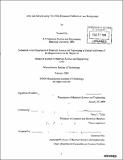Toxic gas sensors using thin film transistor platform at low temperature
Author(s)
Jin, Yoonsil
DownloadFull printable version (47.28Mb)
Other Contributors
Massachusetts Institute of Technology. Dept. of Materials Science and Engineering.
Advisor
Harry L. Tuller.
Terms of use
Metadata
Show full item recordAbstract
Semiconducting metal-oxides such as SnO₂, TiO₂, ZnO and WO₃ are commonly used for gas sensing in the form of thin film resistors (TFRs) given their high sensitivity to many vapor species, simple construction and capability for miniaturization. Furthermore, they are generally more stable than polymer-based gas sensors. However, unlike polymers, metal oxide gas sensors must typically be operated between 200-400°C to insure rapid kinetics. Another problem impacting TFR performance and reproducibility is related to poorly understood substrate-semiconductor film interactions. Space charges at this heterojunction are believed to influence chemisorption on the semiconductor-gas interface, but unfortunately, in an unpredictable manner. In this study, the feasibility of employing illumination and the thin film transistor (TFT) platform as a means of reducing operation temperature was investigated on ZnO based TFTs for gas sensors applications. Response to NO₂ is observed at significantly reduced temperature. Photoconductivity measurements, performed as a function of temperature on ZnO based TFRs, indicate that this results in a photon-induced desorption process. Also, transient changes in TFT channel conductance and transistor threshold voltage are obtained with application of gate bias, suggesting that TFTs offer additional control over chemisorption at the semiconductor-gas interface.
Description
Thesis (S.M.)--Massachusetts Institute of Technology, Dept. of Materials Science and Engineering, 2009. Includes bibliographical references (leaves [71-73]).
Date issued
2009Department
Massachusetts Institute of Technology. Department of Materials Science and EngineeringPublisher
Massachusetts Institute of Technology
Keywords
Materials Science and Engineering.